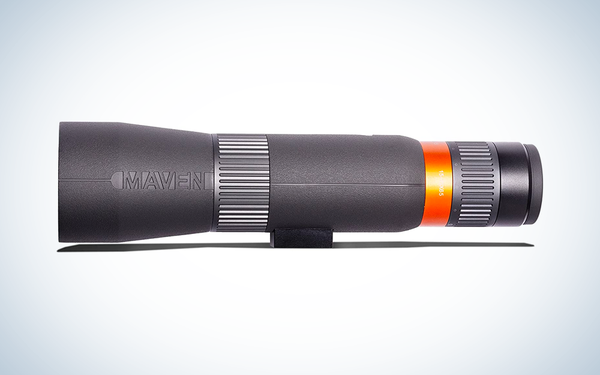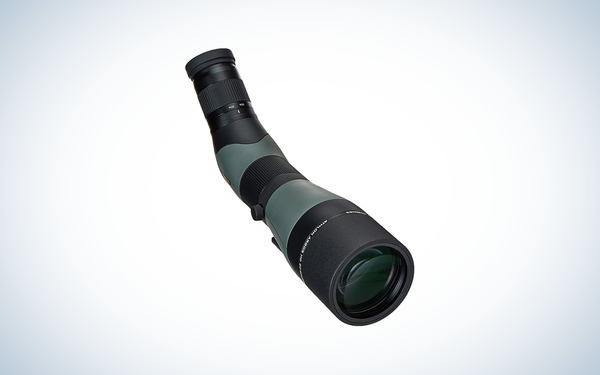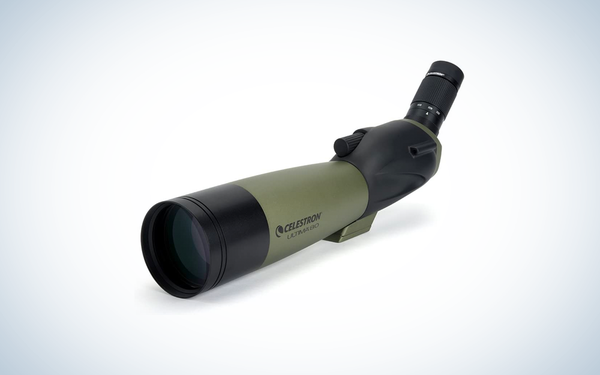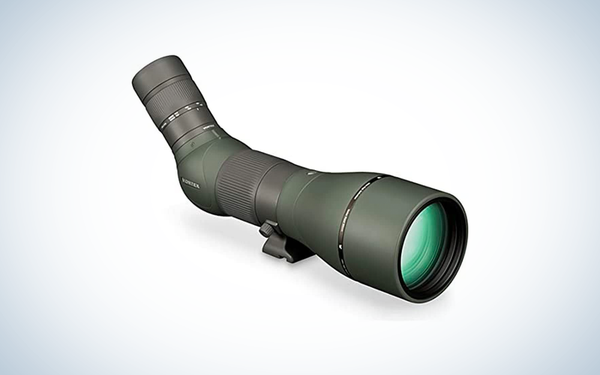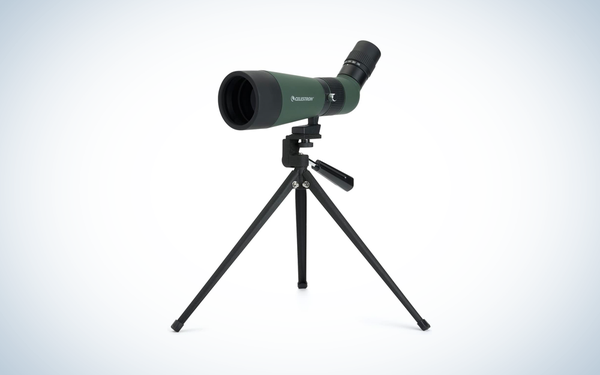We may earn revenue from the products available on this page and participate in affiliate programs. Learn more ›
Spotting scopes for birding are often overshadowed by binoculars—the usual choice of optics by birdwatchers everywhere. But what many don’t know is the role spotting scopes play in birding. Sure, bringing a northern cardinal or flighty steller’s jay ten times closer is nice, but how about putting that same species in your lap, courtesy of a magnification of 30X or 45X? A reliable spotting scope allows you to get up close and personal with your subject so you can see details that a pair of binoculars can’t pick up. Plus, if you combine good binoculars with a reliable spotting scope, then you have the ultimate birding setup.
We rounded up some of the best spotting scopes for birding, as well as some tips and considerations to make sure you get the best possible optics for the field.
How We Picked the Best Spotting Scopes for Birding
It would be easy if there was one style of birding and one model of spotting scope to choose from; however, that’s not the case. Some birders are more mobile than others, choosing to hike and look rather than sit and let their feathered friends come to them. Some folks prefer a straight eyepiece, while others like an angled one. Here are the parts of the equation I rely on when I’m making the choice as to which spotting scope to put into play.
User-friendliness Rating
I want something quick and easy to operate. Some optics come with enough bells and whistles to make them pretty time-consuming to get on target and bring into focus. With that in mind, I’m looking for a focus knob or wheel that’s ergonomically designed and positioned so I can get to it easily.
Magnification and Objective Lens
Most birders should look for a spotting scope with a magnification range from 20X to 60X, and an objective lens of somewhere between 50mm to 80mm. Anything with less magnification, and you may as well use a binocular. If you go above an 80mm objective lens, then you start to get into issues of size, weight, and expense. It is also worth noting that spotting scopes feature an adjustable magnification, while binoculars have a fixed magnification.
Size and Weight
Like binoculars, spotting scopes come in a wide variety of shapes, sizes, and weights. However, unlike binoculars, spotting scopes are traditionally used from a stationary platform, like a tripod or window mount. As a result, a spotting scope’s size and weight aren’t as much of a consideration as they are with a binocular that’s carried for the entire event. But mobile birds will still want to consider weight, even though the scope is mounted on a tripod.
Glass Quality
The best glass comes at a price, but a common denominator with quality glass is it being Extra-Low Dispersion or ED, and that’s something we were looking for when we made our choices. Dispersion refers to colors of different wavelengths being focused at various points on the glass. Extra-Low Dispersion glass, then, ensures the singularity of a focus point, which translates into a sharper image. Bottom line? You want Extra-Low Dispersion glass.
Best Spotting Scopes for Birding: Reviews and Recommendations
Best Overall: Maven CS.1 15-45X
Specs
- Magnification range: 15-45X
- Objective lens: 65mm
- Weight: 40.4 ounces
- Glass: Extra-low Dispersion
- Field of view: 174’ at 1,000 yards
Pros
- Lightweight magnesium/aluminum frame
- User-friendly full-body focusing ring
- Adjustable eyecup
- Compact design
- Lightweight
Cons
I had a chance to mount the CS.1 on an old Bogen tripod and spy on the tree swallows nesting 100 yards north of my back porch. Overall, I was quite impressed on several different levels. Technically, my scope is a CS.1 15-45X65mm unit. It’s slim and trim, shorter than most at 12 inches long, and tips the scales at just a shade over 40 ounces. Meaning if I decide to pack it into the field, it won’t add too much extra weight to my pack. The forward-mounted focus ring is 1-3/8” wide and grooved to offer a good grip, even when wearing gloves. And the image? Crystal clear.
Best Value: Athlon Optics Argos HD 20-60X
Specs
- Magnification range: 20-60X
- Objective lens: 85mm
- Weight: 70 ounces
- Glass: High Definition
- Field of view: 102’ at 1,000 yards
Pros
- Fairly priced
- Choice of angled or straight tube
- Rubber armor enhances durability
- Extendable sunshade
- Lifetime warranty
- Rotating tripod mounting ring a plus
Cons
- Not Extra-Low Dispersion glass
Some optic manufacturers offer premium glass at a premium price. Now I’m not saying to settle for less, but rather that good optics can still be had without burning a hole in your wallet. And the Athlon Argos is the perfect example. For under $400, birders will find that the Argos HD 20-60X is a rugged scope with just enough bells and whistles, like the rotating tripod mount, to elevate it on the user-friendliness scale. At over four pounds, it’s not light, so chances are you’re going to set it up and use it right there. Still, the Argos is an excellent value for beginner and veteran birders alike.
Best Budget: Celestron Ultima 80 20-60X
Specs
- Magnification range: 20-60X
- Objective lens: 80mm
- Weight: 3.5 pounds
- Glass: High-definition
- Field of view: 105’ at 1,000 yards
Pros
- Affordable
- Multi-coated lens
- Includes T-adapter (cell phone) for digiscoping
- Included soft case
- Good warranty
- Both angled and straight tube options
Cons
Here’s a spotting scope you can afford to carry in your truck 24/7, or even throw behind the seat and really not worry about it. Why? For less than a couple tanks of gas, you have good glass that does what it says it will do—let you see stuff far away—while taking a beating. There’s nothing pretty about the Ultima 80; in fact, I’d call it “brutishly handsome.” But the controls, like the focus knob and zoom adjustment, are well-designed and easy to use. Plus, accessories like the phone adapter, soft case, eyepiece pouch, and limited lifetime warranty are all nice. It comes in both angled and straight models and only costs $180.
Best Angled: Vortex Razor HD 27-60X
Specs
- Magnification range: 27-60X
- Objective lens: 85mm
- Weight: 4.10 pounds (20-60×85)
- Glass: Extra-low Dispersion/High Def
- Field of view: 117’ at 1,000 yards
Pros
- High-end ED/HD glass
- ArmorTec scratch-resistant coating
- Custom-fit neoprene case
Cons
Vortex has an impressive following among the hunting community, and their reputation is spilling over into other outdoor enthusiast groups, birdwatchers very much included. The Razor HD is rugged and durable, comes in both angled and straight tube versions, and features a light-sucking 85mm objective lens. Yes, it is a little heavier and more expensive, but if first-light hummingbirds are your target species, the Razor HD will get you up close and personal.
Best for Kids: Celestron LandScout 12-36X
Specs
- Magnification range: 12-36X
- Objective lens: 60mm
- Weight: 1.1 pounds
- Glass: Fully-coated
- Field of view: 157’ at 1,000 yards
Pros
- Very affordable
- Tabletop metal tripod and soft case included
- Extra-large focus dial/knob works well with kids
- Soft padded eyecup
- Limited lifetime warranty
- Tripod mount spins 360 degrees
Cons
- Build quality isn’t the best
Kids are tough on gear. Still, you want the little ones to participate in all aspects, but you just don’t want them fiddling with your $2,000 spotting scope. Enter the LandScout from Celestron. For right around $100, your young birder will have all he or she needs to see that barn swallow in full detail. There are some kid-friendly amenities here too, including a big focus knob and a padded eyecup. Spend another $20 to get the Smartphone adapter and preserve those memories forever.
What to Consider When Buying a Spotting Scope
Truthfully, this list of five prior-to-purchase considerations could be downsized to three—price, magnification, and weight—but we’ll throw field of view and the company’s reputation into the mix, as both are worth giving some thought before you open your wallet.
Price
There are some things worth paying a little more for in order to get the quality and performance you wish. Windshield wipers and toilet paper come to mind. Spotting scopes, too. Get the best you can afford, and remember that cheap glass is probably just that. Cheap glass.
Magnification
This one’s relatively simple, as the two main magnification choices when it comes to spotting scopes are 15-45X and 20-60X. Either should work well for the birder, regardless of the setting or the subject matter.
Field of View
The field of view for a spotting scope isn’t as big a concern as it is for birders buying binoculars. Why? Because scopes are, almost without exception, used to study stationary objects, whereas binoculars are often moved along with a flying, swimming, or walking subject. Think of it this way. Binoculars equal lower magnification and a larger field of view. Spotting scopes equal higher magnification, greater detail, and a smaller field of view.
Weight and Size
If you’re packing a spotting scope down the trail for any distance, then size and weight are a factor. You’ll also have to consider a lightweight tripod. If the spotter is stationary, then a larger objective lens, say, 80-85mm, that lets in more light but is heavier might be an option.
Company Reputation/Service
I’m partial to sticking with a name I know and trust. And I want to be able to contact the company direct if I have a problem with their product. All of the brands recommended above get my seal of approval.
FAQs
Q: Is a spotting scope worth it for birding?
It depends on what your birding objectives are. If basic identification and observation, especially with birds in motion, is your goal, then a binocular might be a better choice. If the goal is an in-depth study, e.g. anatomy, feather detail, or even reading the numbers on a band, then the higher magnification offered by a spotting scope would come in handy.
Q: Is a straight or angled spotting scope better for birding?
Each style has its pros and cons. Mounted on a tall, sturdy tripod and set at one’s eye level, a straight tube is great for the solo birder wishing to spy on his/her subject(s) for long periods of time. Angled tubes, however, can be set at a height to accommodate the shortest member of the group and then easily shared by all.
Q: What’s the best magnification for a bird watching scope?
Best is a relative term, as most birders have their own standards as to the magnification they need for their specific purposes. That said, the two most common zoom ranges—15-45X and 20-60X—will do just fine in most situations.
Q: How much should a good spotting scope cost?
Essentially, you’re working with three price ranges—less than $1,000, $1,000 to $2,000, and over $2,000. Prices are all over the map, so make sure to do your homework and determine what you need out of a spotter before buying one.
Best Spotting Scopes for Birding: Final Thoughts
For most birders, a new spotting scope constitutes a major financial investment, so it only makes sense to do your research prior to the purchase. I’d strongly suggest visiting your local sporting goods store and test-drive several different makes and models. Warranties, repair/replacement policies, and returns, too, should be taken into consideration. Oh, and a good tripod.
Why Trust Us
For more than 125 years, Field & Stream has been providing readers with honest and authentic coverage of outdoor gear. Our writers and editors eat, sleep, and breathe the outdoors, and that passion comes through in our product reviews. You can count on F&S to keep you up to date on the best new gear. And when we write about a product—whether it’s a bass lure or a backpack—we cover the good and the bad, so you know exactly what to expect before you decide to make a purchase.


